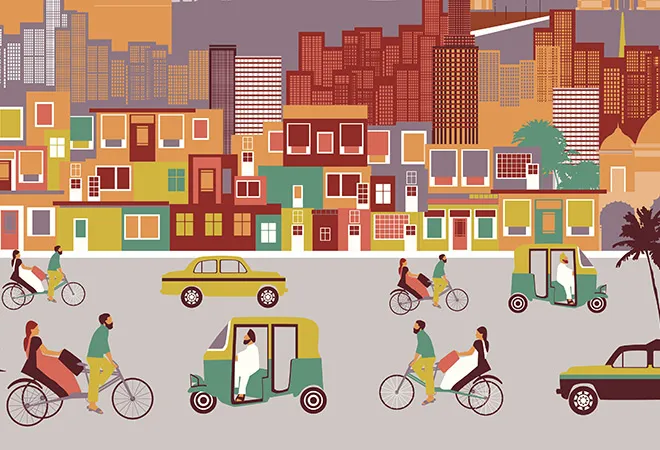
This article is part of the series — Catalysing Change: Women-led Development in the Decade of Action.
In cities, infrastructure is a necessary foundation for achieving sustainable and inclusive socio-economic growth as it directly affects access to education, work, and other services. Yet, cities are often designed without considering the needs of all the members of society. Lack of mobility within cities can lead to geographical segregation — exacerbating inequalities by reducing new opportunities for women and marginalised groups in urban areas. Building infrastructure in cities that is gender-blind can lead to the social and economic exclusion of a large section of the population.
It is necessary to study urban mobility from a gendered perspective as access to safe mobility directly relates to the fulfilment of the 2030 Agenda for Sustainable Development Goals (SDGs). It can ensure women’s effective participation and equal opportunities for leadership in political, economic, and public life (SDG 5.5). Thus, urban development must view women as end-users of transport infrastructure and consider their diverse needs.
Building infrastructure in cities that is gender-blind can lead to the social and economic exclusion of a large section of the population.
The gendered perspective of transport
Often due to differences occurring in socially-constructed gender roles, women are predisposed towards certain travel characteristics that are distinct from those of men. These differences in travelling patterns can be due to several reasons such as variation in responsibilities, safety concerns, lesser income, and lower bargaining and decision-making powers.
Safety is a major concern raised by women regarding limited access to urban transport; the incidence of gender-based violence is higher for women. A report on Women and Mobility by the Asia Foundation, showed that 50 percent of sexual harassment cases against women in cities took place while using public transport and 16 percent while waiting for public transport. It was also found that poor infrastructure including lack of street lights, public toilets, and useable pavements, made travelling by public transport more uncomfortable and unsafe.
Safety is a major concern raised by women regarding limited access to urban transport.
Further, it was observed that long distances are a major deterrent for women’s participation in the labour force. An Informal Economy Monitoring Survey highlighted that women in urban areas are more likely to decline better paid jobs that are far away from their homes for lower-paid, local opportunities — primarily as urban transport does not account for their needs of affordability, safety, comfort, and security. In another instance, it was found that when women were displaced in Delhi from an informal settlement to the periphery of the city, their employment fell by 27 percent.
Women also have fewer mobility options and are highly dependent on public, intermediate public transport or non-motorised forms of transport. As income-generating jobs are given precedence over caregiving or domestic responsibilities, women are less likely to use private transport. The COVID-19 pandemic has further decreased mobility options for women. Due to high congestion and the need for social distancing, there has been a decrease in the use of mass-transportation services by women. In Delhi-NCR, for example, the share of metro services for female commuters has decreased by 16 percent post COVID-19.
Due to high congestion and the need for social distancing, there has been a decrease in the use of mass-transportation services by women.
Eyes on the street
Personal safety is one of the most important factors affecting women’s choices and preferences for transport in India. Better designed physical infrastructure such as wide pathways with sufficient lighting, eliminating dark corners and view-obstructing structures, universally accessible interchanges, public toilets, women-dedicated safe parking spaces, and adequate seating arrangement can not only facilitate non-motorised mobility but also improve last or first-mile connectivity for public transport.
In 1961, author Jane Jacobs highlighted the importance of informal surveillance of the urban environment. In her concept of “eyes on the street,” informal surveillance through vibrant public spaces can make people feel safe, despite being among strangers. Building a congenial atmosphere near public transport interchanges in the form of restaurants or shops can create vibrant community spaces. This bottom-up community planning approach can create networks of mutual care and provide indirect surveillance for women.
Building a congenial atmosphere near public transport interchanges in the form of restaurants or shops can create vibrant community spaces.
Overcrowding can lead to a higher incidence of sexual harassment. Due to safety concerns, women have a narrower time frame to travel by public transport. The reduced ‘safe window’ can increase congestion during certain hours and make public transport less reliable and safe. To reduce congestion, transport services must be boosted by increasing the frequency of short-distance mobility services, creating a flexible fare structure to ensure multi-journey tickets. GPS-enabled night taxi services by women drivers can improve safety during non-peak hours.
Safety concerns can be addressed through increased surveillance at key transport interchanges. This can be ensured through more women being employed in leadership roles as transport sector authorities, active CCTV monitoring with a dedicated task force, and GPS tracking services. In most Indian cities, intermediate public transport such as taxi services, auto-rickshaws and cycle-rickshaws are not formally registered; this makes it difficult for them to be traced. Despite the existing Central Motor Vehicle Act 1988 and the State Motor Vehicle rules, there is no institution to upgrade the intermediate public transport (IPT) with respect to routes, fares, vehicle performance, and technology services. To ensure safety and effective tracking, it is necessary to constitute a regulatory authority to ensure uniformity within the IPT services.
It is essential to carry out a modal split, where the percentage of male and female residents using particular forms of transport is assessed.
Typically, little attention is given to gender differences in travel patterns due to a lack of gender-disaggregated statistics. It is essential to carry out a modal split, where the percentage of male and female residents using particular forms of transport is assessed. More gender-disaggregated data can help understand women’s travelling patterns and demands, including the mapping of routes used by women, the reasons for lack of safety, and the availability of amenities around modes of transport.
Improved mobility not only broadens women’s economic and social opportunities but also plays an important role in curbing urban congestion and environmental damage. Limited access to safe transportation can increase women's ‘hidden barriers’ in participating in the labour market as well as negatively impact their access to other services such as education or health, especially during the pandemic. Thus, women’s reclamation of public spaces is a requisite for the realisation of their right to the city and inclusive urban development.
The views expressed above belong to the author(s). ORF research and analyses now available on Telegram! Click here to access our curated content — blogs, longforms and interviews.




 PREV
PREV


